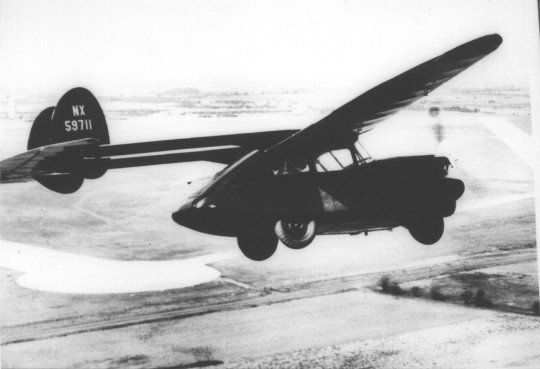This article originally appeared in the Garland/Mesquite section of The Dallas Morning News on April 28, 1995.
By Michael R. Hayslip
One of Garland’s worst-kept secrets after the close of World War II was the flying car project at Southern Aircraft Corporation. Almost everybody in town knew about it, but not much.
Originally designed by Theodore Hall, an engineer at Consolidated Aircraft in California, the car was built, flown and driven there before the war as a prototype. Though sidetracked by defense production needs, the concept stuck in the mind of Willis C. Brown, president of SAC, which supplied tail and nose turrets for Consolidated’s B-24 bomber.
Brown was intrigued by the possibility of a general-purpose passenger car that could accept wings, tail and propeller available for temporary attachment at a neighborhood airport. The driver/pilot could spin around town on rubber-tired wheels or take to the air for longer hauls, checking in his attachments at the destination.
After the war’s end in 1945 the car and its wings quietly arrived at Southern Aircraft’s Garland plant, which needed products for peacetime production. SAC had agreed to complete further development on the vehicle, called the “Roto Mobile” within specific time lines; otherwise, it would be returned to California. Meanwhile, a photo of the car had appeared on the cover of LifeMagazine.
Behind closed doors, work resumed under the direction of Orin Moe, a veteran SAC engineer, who ordered certain modifications. E. M. Johnson, Jr., another SAC engineer working simultaneously on development of a twin-engine plane, recalls that engine power was a concern for both projects. Nevertheless, the flying car was eventually driven to Majors Field in Greenville, where employees saw it fly briefly.
Renamed the “Southern Roadable,” the little two-seater machine resembled an 1,800-pound locust with a 30-foot wingspan. Top airspeed was 128 miles per hour, with a cruising speed of 110. When driven as an automobile, its rudder controls activated the clutch and brakes.
Due in part to financial strains and changes in ownership three years after the war ended, Southern Aircraft failed to complete its commitment on time, and the modified prototype was returned to California as agreed. Since its west coast originators eventually abandoned the project, the flying car was acquired by the San Diego Air Museum, where it remained on display until destroyed by an arsonist’s blaze in 1979.
Meanwhile, Southern Aircraft became Intercontinental Manufacturing Company, or IMCO, a name retained today through six successive ownerships since the original group headed by Brown. Though the succeeding owners never attempted another flying car, IMCO has distinguished itself by producing bomb bodies, rocket motor cases and precision products for aeronautical and space needs.
The flying car, seen around Southern Aircraft after WWII.


